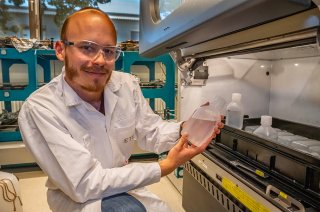
category_news
Reducing PFAS concentrations in drinking water
PFAS is a group of industrial chemicals that have dispersed in the environment, including drinking water. ETE PhD student Marko Pranić is developing tools to help drinking water companies to remove these substances during the water purification process.
Polyfluoralkyl substances, PFAS, are industrial, persistent chemicals that are dirt-, water-, and fat- repellant. They are used in many consumer products, for example lubricants, water-proof clothing, anti-stick cookware and fire fighter foam. However, their properties also make them spread and accumulate in the environment, and they easily find their way into our food and drinking water.
Activated carbon
There are thousands of different types of PFAS, of which a few dozen are regulated. Exposure to PFAS occurs for about 80% through food and 20% through drinking water. Drinking water companies use activated carbon to remove contaminants from water. This porous material has a huge surface to volume area and many of these substances efficiently stick to the surface of the many pores inside activated carbon. ‘But for PFAS this is not very effective, and removal is very slow’, Pranić says. ’In addition, activated carbon appears to become saturated for PFAS quite quickly, and costly reactivation of the carbon is needed.’
Slow removal
To solve the problems to remove PFAS from drinking water, Pranić tries to understand what exactly happens with PFAS during drinking water treatment, particularly, inside the carbon filters. ‘Maybe there is competition with other substances to stick to the coal, like organic substances or ions in the water’ Pranić hypothesizes. But even in pure water, without any other components, PFAS removal is very slow, his experiments show. ‘The models we use to describe the removal process, suggested that the PFAS mobility along the internal carbon surface is very slow, and it consequently takes time for PFAS to adsorb, Pranić explains. ‘During drinking water treatment, the water flow through the carbon filter could easily drag the PFAS from the coal surface before it is adsorbed, so it isn’t removed effectively.’
Eventually, Pranić hopes to better understand what’s happening exactly during the purification process and supply tools for a more effective PFAS removal from drinking water. For example, by changing temperature, using a different kind of active carbon, or by pre-treating the water to achieve a better ion composition for removal.